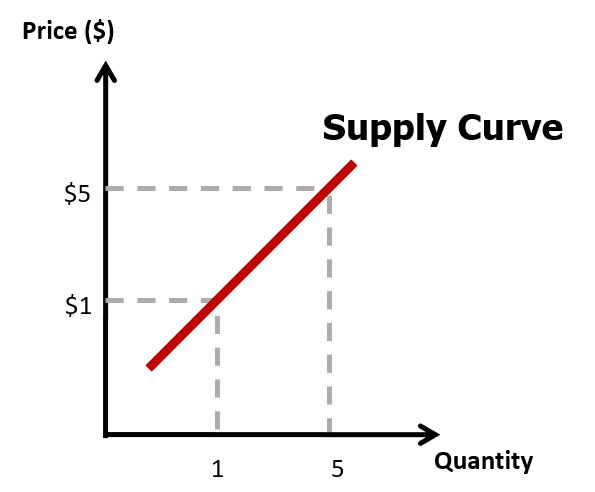Supply Curve
Understanding the supply curve
Supply can be defined as the quantity of any good and services offered for sale at a given price over a period of time in a given market.
Just like there is a ‘Law for Demand’ for the demand curve, in there is a corresponding ‘Law of Supply’ for the supply curve that states that the higher the price, the higher will be the quantity supplied. This essentially makes the supply curve upward sloping.
Let’s assume the case of a single firm supplying a commodity, and let’s further assume that this firm is a small outfit and it is a price taker. Essentially, if the firm is able to sell a product at a higher price, they will be motivated to sell more quantity. However, if they are only able to sell at a low price, then they will be motivated to sell less quantity of that product. Hence, changes in price would simply be a movement along the supply curve.

What can shift the supply curve?
1. Costs of production
Essentially, if the costs of production are to increase, then this will decrease the supply (this means that the supply curve will shift left). If the production costs are to decrease, then this can lead to an increase in supply (this means that the supply curve will shift right). Production costs can change due to:
- Factor Price (or Input Prices) — e.g. increase in electricity, raw materials –> will increase the cost of production –> supply will decrease
- State of Technology — better the technology –> will decrease the cost of production –> supply will increase
- Change in Organization — reorganization that improves productivity –> lower the cost of production (as some redundancies are removed) –> supply will increase
- Change in Government Policy — e.g. taxes or subsidies :
- (a) Cost can increase (via tax) –> supply will decrease
- (b) Cost can decrease (via subsidy) –> supply will increase
2. Profitability of alternative products
A firm may produce several goods, if another good is more profitable, then the firm may allocate more resources to produce the more profitable goods instead leading to a decrease in supply of this good that is comparatively less profitable.
3. Price of goods in joint supply
A joint supply refers to situation in which an increase or decrease in the supply of one good leads to an increase or decrease in supply of another. For example:
- An expansion in the volume of beef production will lead to a rising market supply of beef hides.
- A contraction in supply of lamb will reduce the supply of wool.
4. Expectations of future price changes (by producers)
If a firm expects that the price of a good will increase tomorrow, they will reduce the supply today so as to charge higher prices tomorrow.
5. Aims of the producer – aiming for high margins or market share
- If a firm producing a good is to embark on a “High profit market objective”, then they may lower the supply so that they can increase the price, and hence increase their profit.
- If the firm producing a good is to embark on a “Market penetration objective”, then they may increase the supply of the product. This will hence decrease the price and hence capture larger market share, but they would then take a lower profit.
6. Weather Conditions/Random Shocks/unpredictable events
Unpredictable events such as an extreme weather conditions like a cyclone may destroy crops or production facility, hence decreasing the supply of the firm’s good.
